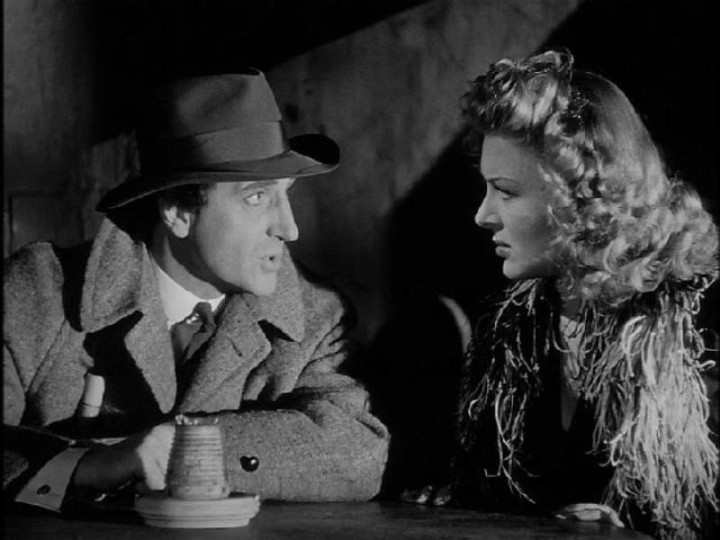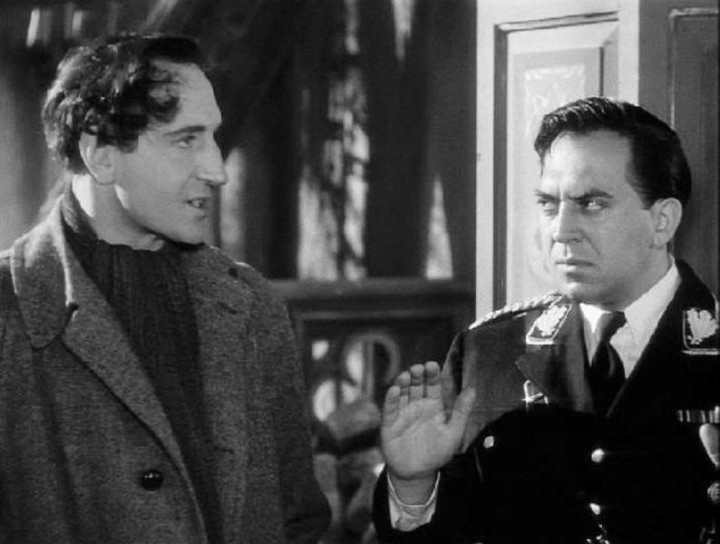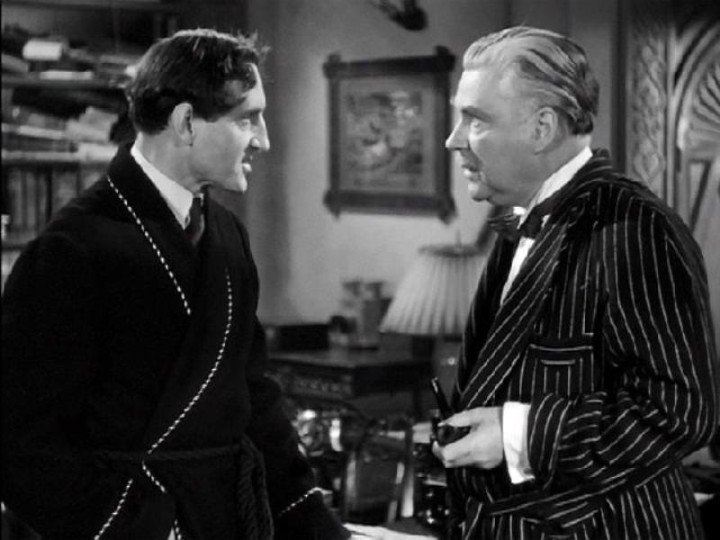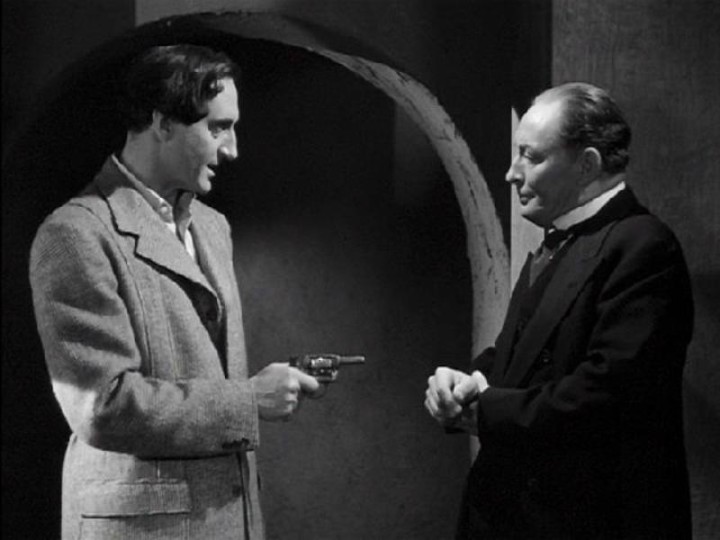I know a lot of Holmes purists have issues with Basil Rathbone-Nigel Bruce series — especially those made at Universal in the 1940s. Yes, I know that Watson wasn’t the befuddled comic character that Bruce played in these movies. This does nothing to change the fact that they were and are the image of the characters for a few generations — maybe especially for those of us who grew up in the 1960s and 70s. It was these films — mostly the Universal ones, since their two Fox titles from 1939 were rarely seen — that introduced us to Holmes and Watson. No, Watson shouldn’t be a bumbling fool. No, Holmes oughtn’t have the…peculiar hairstyle he sports in the first few films. No, Holmes didn’t really fight the Nazis. The problem is that no amount of education can really erode the image of Rathbone and Bruce in those 12 low-budget pictures. If you grew up on them, that opening shot with Frank Skinner’s music still produces a little thrill. And the truth of the matter is, most of those films — particularly the ones through 1944 — are marvelously entertaining whether or not they’re faithful to Doyle.
Universal wasn’t the first to modernize Holmes for the screen. After all, it’s just a lot more economical not to make period movies. They were, however, the first to be so deliberate about it. The first and third (why the second was skipped, I don’t know) films even start with a title informing us, “Sherlock Holmes, the immortal character of fiction created by Sir Arthur Conan Doyle, is ageless, invincible and unchanging. In solving significant problem of the present day he remains — as ever — the supreme master of deductive reasoning.” One might taking issue with how closely they stuck to the idea of “unchanging,” but they left no doubt that this wasn’t going to be the expensive Victorian era Holmes — and it surely surprised no one that “significant problem of the present day” meant the war effort. The first entry went an extra step in modernizing the great detective. Just as he and Watson are leaving Baker Street to undertake their premiere case for Universal, Holmes starts to put on his deerstalker, only to have Watson admonish him, “Holmes, you promised,” causing the detetctive to don a more modern chapeau.
That first entry, Sherlock Holmes and the Voice of Terror (1942) turned out to be the only one that pitted him directly against the common garden variety Nazi. Later entries pitted him against master criminals who just happened to be in the employ of the Third Reich. It was perhaps just as well, because the obvious Nazi (Thomas Gomez) isn’t a very compelling character, while the secret Nazi is reasonably obvious and smacks of something out of E. Phillips Oppenheim’s The Great Impersonation (which was being remade by Universal that same year by the same director, John Rawlins). Plus, the patriotic speechifying throughout the film dates more than anything else in it. (Evelyn Ankers probably enjoyed playing a patriotic Cockney denizen of the underworld as a break from being the studio’s resident scream queen, though.)
Even so, the film is fast-paced and fun with just the right amount of comedy. In most ways, it sets the tone and the look for the films that follow. And while, yes, Watson is a figure of fun, it’s equally clear that “good old Watson” is the one person in the world that Holmes truly cares for. Plus, Watson is considered competent enough to see to a badly wounded character without question. It certainly caught on enough with the public to warrant a follow-up film — the generally superior Sherlock Holmes and the Secret Weapon later that same year.
This second film brought in director Roy William Neill, a far more stylish filmmaker who would make all the subsequent entries. The visual style was set to a great degree by the studio (all of their early 1940s films have a distinctive look), but Neill was more attuned to camera placement and movement. The one thing that Neill seems to have lacked — by all accounts — was much of a sense of humor. He simply didn’t know what was funny, but this had an upside in these films, since he didn’t try for laughs. While Watson’s antics could be pretty broad, the tone remained agreeably dry.
Secret Weapon is still very much a product of its time with the object of interest being a revolutionary bomb invented by Dr. Franz Tobel (William Post, Jr.). Both the British and the Nazis are determined to have the thing, of course, even though Tobel has offered it to the Allied cause and has been spirited to England by Holmes himself. But the Nazis have a very noteworthy adversary in their employ — none other than Holmes’ arch-enemy Professor Moriarty (Lionel Atwill at his world-weary best). The story is clevely developed and designed to give Holmes and Moriarty two showdowns — a fairly minor one and a big one at the climax. (The big one is a pure delight.) Surprisingly, the film is allowed to make it clear that Moriarty is addicted to opium, and they even slip in a reference to Holmes’ cocaine use. (I don’t know how the first got past the censors, I suspect they just didn’t get the import of “The needle to the last, eh, Holmes?” in the context of the film.) With this entry, the series really hits its stride.
The Asheville Film Society will screen Sherlock Holmes and the Voice of Terror and Sherlock Holmes and the Secret Weapon Tuesday, Oct. 14, at 8 p.m. in Theater Six at The Carolina Asheville and will be hosted by Xpress movie critics Ken Hanke and Justin Souther.










I consider myself a Holmes die-hard, if not a purist, and I love these films. It took me a while to get past Rathbone’s hairstyle, but eventually I learned to see past it the same one must forgive the dodgy effects work in old Dr Who episodes. SECRET WEAPON is one of my favorite of the modern Rathbones, along with PEARL OF DEATH and THE WOMAN IN GREEN – Henry Daniell was the best of the Universal Moriartys for my money.
Are you screening these from the great remastered versions that came out a few years back?
The Blu-rays of the same. This was actually my first exposure the set — and I also looked at the plain DVDs — and I was actually disappointed that the quality wasn’t better than it is. Compare these with, say, the Charlie Chan film Dead Men Tell (same era) and these are pretty shabby. My guess is that the original elements aren’t around.
I’ve never seen the Chan restorations, but I saw so many godawful public domain DVDs of SECRET WEAPON that the new version was revelatory to me.
These films both clock in at around the 70 minute mark, which makes you wonder why people can’t make light thrillers with the same efficiency these days.
Well, I think a lot of it has to do with the idea of people not wanting to pay current ticket prices for something that short.
I suspect you’re right, but what a boneheaded way of thinking from the audiences. I can think of plenty of films I’d pay extra money to see shorter versions of, and only one film I’ve seen that I wished was longer (and that’s only by about thirty seconds).
Btw, the website is now telling me I’m “the cat’s pajamas”.
Nonsense. The website seems to be very British and tells me I’m the “cat’s pyjamas.”
You’re the coliseum.
You’re the Louvre Museum.
The boy must be all Portered out.